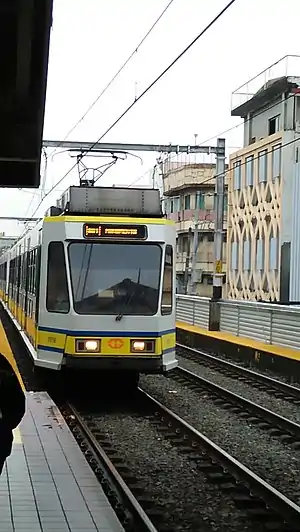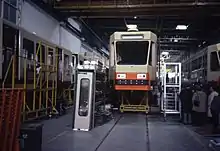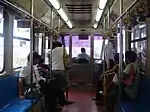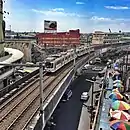LRTA 1000 class
The LRTA 1000 class is a class of high-floor light rail vehicles (LRV) currently operated by the Light Rail Manila Corporation. It first entered service under the Light Rail Transit Authority in 1984.
| LRTA 1000 class First-generation LRV | |
|---|---|
 Newly refurbished 1st Generation LRT 1 trains with LED destination front display | |
| In service | 1984–present |
| Manufacturer | BN Constructions Ferroviaires et Métalliques |
| Built at | Bruges, Belgium |
| Constructed | 1982–1983 |
| Entered service | December 1, 1984 |
| Refurbished | 2003–2004 (LRTA) 2016–present (LRMC) |
| Scrapped | Began scrap of broken down fleet at 2000 |
| Number built | 64 vehicles (32 sets, initially 2-car sets)[1] |
| Number in service | 41 vehicles |
| Formation | 2–3 cars per trainset (bi-articulated car body) |
| Fleet numbers | 1001–1064 |
| Capacity | 374 per car |
| Operator(s) | Light Rail Transit Authority Light Rail Manila Corporation |
| Depot(s) | Baclaran |
| Line(s) served | LRT Line 1 |
| Specifications | |
| Car body construction | BI Sheet |
| Train length | 59,590 mm (195 ft 6 in) (2-car trainset) 89,370 mm (293 ft 3 in) (3-car trainset) |
| Car length | 29,280 mm (96 ft 1 in) |
| Width | 2,500 mm (8 ft 2 in) |
| Height | 3,272 mm (10 ft 8.8 in) (without added AC unit)[2] 3,525 mm (11 ft 6.8 in) (with added AC units) |
| Floor height | 900 mm (2 ft 11 in)[3] |
| Doors | 5 "BN" swing plug-type per side, opening space of 1,300 mm (4 ft 3 in)[4] |
| Wheel diameter | 660 mm (new) |
| Maximum speed | 80 km/h (50 mph) |
| Weight | 41 t (41,000 kg) (2-car trainset)[5] |
| Traction system | Thyristor Chopper (ACEC) |
| Traction motors | DC series-wound motor |
| Power output | 218 kW (292 hp) |
| Transmission | Right-angle link drive |
| Acceleration | 1.0 m/s² (3.28 ft/s²) |
| Deceleration | 1.3 m/s² (4.27 ft/s²) (service) 2.08 (6.82 m/s²) (emergency) |
| Electric system(s) | 750 V DC overhead wire |
| Current collection method | Single-arm pantograph |
| Bogies | Inside-frame type |
| Minimum turning radius | 25 m (82 ft 0 in)[6] |
| Safety system(s) | ATS |
| Track gauge | 1,435 mm (4 ft 8 1⁄2 in) |
Purchase
The Line 1 was constructed through a loan given by the Belgian Government. An additional loan package was given by ACEC (Ateliers de Constructions Electriques de Charleroi), BN (Constructions Ferroviaires et Metalliques, formerly Brugeoise et Nivelles), TEI (Tractionnel Engineering International), and TC (Transurb Consult) to the construction of the line. The trains were included in the second loan package.[7]
The trains were manufactured by BN (now Bombardier Transportation Belgium S.A.), while the electrical equipment supplied were from ACEC. A total of 64 trains were built between 1982 and 1983.
Design
Structure
The length of car is 29,280 mm (96 ft 1 in), 2,500 mm (8 ft 2 in) of width and 3,525 mm (11 ft 6.8 in) of height. The LRVs are double-articulated with 5 door swing plug-type doors per side, and is an 8-axle rigid body. The carbody is made of BI sheet.
Prior to the first refurbishment, the 1000 class wore an orange and cream-white livery under the "Metrorail" branding, and notably had "mushroom-cap" roof-mounted ventilation.
 LRT 1000 class LRVs under construction in the BN plant in Bruges, Belgium
LRT 1000 class LRVs under construction in the BN plant in Bruges, Belgium Interior of 1000 class LRV (first refurbishment).
Interior of 1000 class LRV (first refurbishment). A two-car 1000 class LRV approaching EDSA station
A two-car 1000 class LRV approaching EDSA station
Operations
The trains originally ran on a two-car configuration. In 1999, it was converted into a three-car configuration when LRTA refurbished the trains and purchased 7 four-car trains from Hyundai Precision.[1] Not all of the train cars are capable to be coupled to form three-car sets however.
The trains are planned to be eventually replaced by the new and numerous LRTA 13000 class LRVs.
Phase 1
In the early 1990s, the line faced problems due to poor maintenance and overcrowding. In addition, the forced ventilation units could no longer cool the trains properly.[8]
In 1999, thirty-two 1st generation LRVs underwent refurbishment. Generally, this involved the repair of the carbody. The project included the introduction of the new livery, replacement of seats and other interior modifications, installation of new components, and modification of the roof for the installation of air conditioning units. Replacement and cleaning of electrical components were not included.[9]
Phase 2
The thirty-one remaining LRVs that were not modernized in Phase 1 underwent refurbishment in 2004. The electrical components of the thirty-two LRVs refurbished in Phase 1 were cleaned and replaced. As of February 28, 2009, the project is complete.[10]
Second Refurbishment (2016-present)
The Light Rail Manila Corporation (LRMC) took over the operations and maintenance of Line 1 on September 12, 2015.[11] At that time, there were only 77 running LRVs.[12] To increase the running trains and reduce the headway, the company initiated the second refurbishment of the 1000 class LRVs in 2016 worth Php 1 billion.[13]
The refurbishment includes the removal of rust from the carbody, repainting, replacement of flooring, and installation of new LED lightings and signaling systems.[14] Out of service LRVs were also repaired and reentered revenue service.[15]
As of May 31, 2017, there are a total of 102 running LRVs in the LRT 1, increasing the trips from 498 to 554.[15]
Incidents and accidents
On Rizal Day in the year 2000, a train (car number 1037) exploded at Blumentritt station as part of a series of explosions in a terrorist attack known as the Rizal Day bombings. The attack on Line 1 killed some 22 people and injured hundreds. The damaged train was decommissioned immediately after the incident. No confirmed plans were announced on its ultimate fate, whether it would be restored or scrapped.[16] The train, together with other trainsets involved in accidents, were stored at the Line 2 Santolan Depot in Pasig and were ultimately sold for scrap.
On February 18, 2011, two trains (3G and 1G trains) collided near Roosevelt Station in Quezon City on Friday at the reversing tracks, around a kilometer away to the east. No passengers were injured. The cause of the collision is yet to be determined, whether due to driver error or technical malfunction.[17]
On May 23, 2015, thousands of passengers were stranded after a train of Line 1 slammed into another train near the Monumento station. A train driver was hurt after the impact caused his head to slam into the dashboard of the train.[18] The accident, later revealed to be caused by power fluctuation that affected the signalling system, forced passengers to alight from the station until services was restored around 1 pm at the same day.[19]
References
| Wikimedia Commons has media related to LRTA Class 1000. |
- "MANILA LRT1 EXTENSION, OPERATIONS AND MAINTENANCE PROJECT" (PDF). The Official Site Public-Private Partnership center of the Philippines. Retrieved April 9, 2018.
- "BN Light Rail". Retrieved August 31, 2020.
- "BN Light Rail". Retrieved August 31, 2020.
- "BN Light Rail". Retrieved August 31, 2020.
- "BN Light Rail". Retrieved August 31, 2020.
- "BN Light Rail". Retrieved August 31, 2020.
- "LRTA History". lrta.gov.ph. Retrieved May 23, 2018.
- Satre, Gary (June 1998). "The Metro Manila LRT—A Historical Perspective" (PDF). Japan Railway & Transport Review. 16: 33–37.
- Light Rail Transit Authority. "The LRT Line 1 Rehabilitation I Project Phase 3 - Rolling Stock Rehabilitation". Archived from the original on November 17, 2010. Retrieved February 13, 2020.
- Light Rail Transit Authority. "The LRT Line 1 Modernization Phase II-Project: Modernization and Upgrading of Existing BN ACEC LRVs". Archived from the original on March 21, 2009. Retrieved February 13, 2020.
- Cabacungan, Gil; Camus, Miguel (September 15, 2015). "LRT1 now under Ayala, Metro Pacific management". Philippine Daily Inquirer. Retrieved March 30, 2019.
- Light Rail Manila Corporation (December 15, 2016). "LRT-1 now operates with 96 light rail vehicles » Light Rail Transit Manila | Light Rail Manila Corporation". Light Rail Manila Corporation. Retrieved February 13, 2020.
- "LRMC spending P1B to rehabilitate old trains of LRT-1". Interaksyon. June 8, 2017. Retrieved February 13, 2020.
- Marasigan, Lorenz (June 7, 2017). "25 LRT 1 trains complete P1-billion rehabilitation, LRMC head says". BusinessMirror. Retrieved February 13, 2020.
- Dela Paz, Chrisee (June 7, 2017). "LRT1 operator completes restoration, vows more daily rides soon". Rappler. Retrieved February 13, 2020.
- Tubeza. Philip (July 8, 2003). "Terrorist raps filed vs Asia's most wanted man". Inquirer. Archived from the original on December 6, 2003.
- Castro, Doland (February 18, 2011). "2 LRT trains collide". Quezon City, Metro Manila. Archived from the original on May 26, 2020. Retrieved May 26, 2020.
- Gonzales, Yuji Vincent (May 23, 2015). "2 LRT trains collide due to technical glitch; at least 1 hurt". South Caloocan, Metro Manila. Archived from the original on February 4, 2016. Retrieved May 26, 2020.
- Palma, Paola (May 23, 2015). "Minor collision disrupts LRT operation Saturday". Metro Manila. Retrieved May 26, 2020.